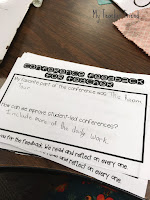Recently I found a long-forgotten college assignment. During the most grueling and demanding literacy course of my undergraduate degree, we were ask to do an ACCNE assignment. ACCNE stood for Absolutelies (things we will most definitely do), Could-be-Cools(we might try), and Never-Evers (practices that we disagree with using). We were instructed to compile a simple list of teaching practices that would fit into each category. Upon re-reading my lists 14 years later, I was pleasantly surprised at how well I had adhered to my college idealism. Most of my never-evers were practices that I had avoided.
The one practice on my never-ever list that I had used was round robin, or popcorn, reading. I am sure you have read excellent articles like
this one from Jennifer Gonzalez at Cult of Pedagogy encouraging teacher to kick this strategy, among others, to the curb. I agree with her now and did as a college student. Then, why did I use it?
I can remember as a brand new teacher feeling overwhelmed and under an enormous amount of pressure to perform and be a "real teacher." Teachers that I knew and respected used round robin reading. Honestly, I was just doing good to even hold small reading groups and keep my students who were not at the table engaged in any task at all. My management was mediocre and my experience was nearly none. Round robin reading made me feel like I could check small reading groups off of my list. It was easy. No planning required. I held my group, I heard students read. Done.
As I became a better teacher, the little 22 year-old voice in the back of my head never stopped piping up. I was able to implement better, more student-friendly, research-based strategies at my table. Thank goodness.
Fast forward to today. A wonderful and talented new teacher walks into my room and asks for advice. She has been attempting to implement Take-a-Break as the behavior system in her classroom. I successfully use TAB in my fourth grade classroom. She knows it hasn't been yielding the results she desires. And she has been asking the advice of other primary teachers who she respects. Sound familiar?
She confides that she has been encouraged to scrap the Take-a-Break strategy for one or all of her students, instead opting for a "stoplight system" to track behaviors. I can sense her uneasiness about it, so I ask her "How do you feel about that?" She explains that she feels hesitant. She has bad memories of being on a similar system as a student. She goes on to share about how she knows which of her students will be "on red" more often than not and that she hates the idea of doing that to them.
I feel that this scenario, like so many for new teachers, is complicated. Here is some wisdom for new teachers or anyone influencing new teachers:
1. Take the next best step
Make the best choice for your students you can at the time. I don't look back on my experience of using round robin reading as a failure. I was able to learn about my students as readers through the process. I was able to feel the discomfort of using a not-so-great technique. That makes me more empathetic to students. Round robin wasn't best practice, but I sorted out issues with the way I handled discipline and assigning center work during that time. Once those things were under control, I was more equipped to move on to meaningful work at the table. I also learned a lot about monitoring oral reading that I was later able to integrate into MIRP (Monitoring Independent Reading Practice).
Making the next best step means doing your best at the moment. Make the choice that you can look back on and be proud, knowing you did the best you could.
2. Give yourself grace
You are not going to have all the right answers at the beginning of your career. I won't tell you to not try to make every day the best possible. I know you will push yourself too hard and work too late. Instead, I will tell you to create systems that you can sustain. You do not need to make every single component of your classroom perfect within your first couple of years of teaching. Pinterest and Facebook are full of perfect photos of perfect classrooms. Believe me, so much of it is a snapshot of one moment. You do not need to laminate all the things. Sure, lamination is shiny and smells like heaven, but ain't nobody got time for that. For every photo of a perfectly executed lesson or bulletin board I post, about a hundred shortie pencils and empty water bottles and coffee cups lurk on my desk. Not to mention the pile of grading and unread emails.
3. Listen to your heart
I am not saying that spotlight behavior systems are the devil. I am saying that if you are feeling uneasy about implementing a certain practice, there is probably a good reason. Be reflective. Find a teacher friend who listens to you and helps you figure out all the mysteries of the classroom for yourself. It would have been easy for me to tell my teacher friend exactly what I think about stoplight charts. That wouldn't have been as helpful as asking her what she thinks. If you are mentoring new teachers,
this post could be help you hone your listening skills.
4. Celebrate your successes, big and small
I was more than shocked to see how much my teaching in reality aligned with my teaching career in the abstract. If you are not lucky enough to have hoarded college assignments, take some time to make your own ACCNE list now. Which techniques, practices, and strategies would you place in each category? Look back at the end of the year (or 14) and see how you did. You guys, I even keep my old to-do lists. They help me realize just how much I have accomplished throughout the year.
As for my new teacher friend, I think we found the perfect plan for her to move forward in the new year. I won't go into details about what she decided, but I will say that the solution is all hers. We will be talking about it again, not because her plan will fail, but because she is a relentless professional who is always looking to be better. I am sure you know someone just like her. I am proud to call her, and you, My Teacher Friend.
If you are interested in seeing the Take-A-Break area, in my fourth grade classroom,
click here.









 .
. 





































